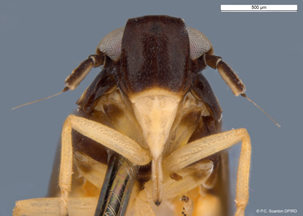Eumetopina flavipes Muir
Island sugarcane planthopper
Caution
Many of the insects depicted on these pages are outwardly similar and you should not use photographs as the sole means of identification. These pages form part of a scientific key which will assist a trained entomologist to identify the species accurately.
Eumetopina flavipes Muir, 1913
Common Name: Island sugarcane planthopper
Subfamily/Tribe: Delphacinae: Delphacini
Distribution: Eumetopina flavipes is found in Malaysia, Borneo, Philippines, Papua New Guinea, Australia (Torres Strait Islands and Cape York Peninsula, Qld), Indonesia, Solomon Islands, and New Caledonia.
Economic Status: Eumetopina flavipes feeds on species of Saccharum, of which sugarcane (Saccharum officinarum) is the most economically important (Anderson et al. 2007). It is the vector of the virus that causes Ramu stunt disease in sugarcane, which is absent from Australia (Anderson 2011; Mollov et al. 2016). For a good account of the disease and its impact, see Plantwise (2017).
Notes: There are eight described species within Eumetopina worldwide (Bartlett 2018), although E. flavipes is the only species present within Australia (Bellis et al. 2013) having recently arrived in northern Qld from PNG (Grimshaw & Donaldson 2007). Bartlett (2018) notes that the flattened nature of Eumetopina species is particularly distinctive within the Delphacini. In PNG, E. flavipes spreads through anthropogenic means, most commonly through human transport of sugarcane (Anderson et al. 2007). Over longer distances, such as to the Torres Strait Islands and northern Australia, Anderson et al. (2010) demonstrated via genetic studies that wind dispersal is most probable. Despite its presence in Australia, this species is still regarded as a quarantine pest (e.g., PHA 2016).

[Images: Pia Scanlon, DPIRB, WA]

